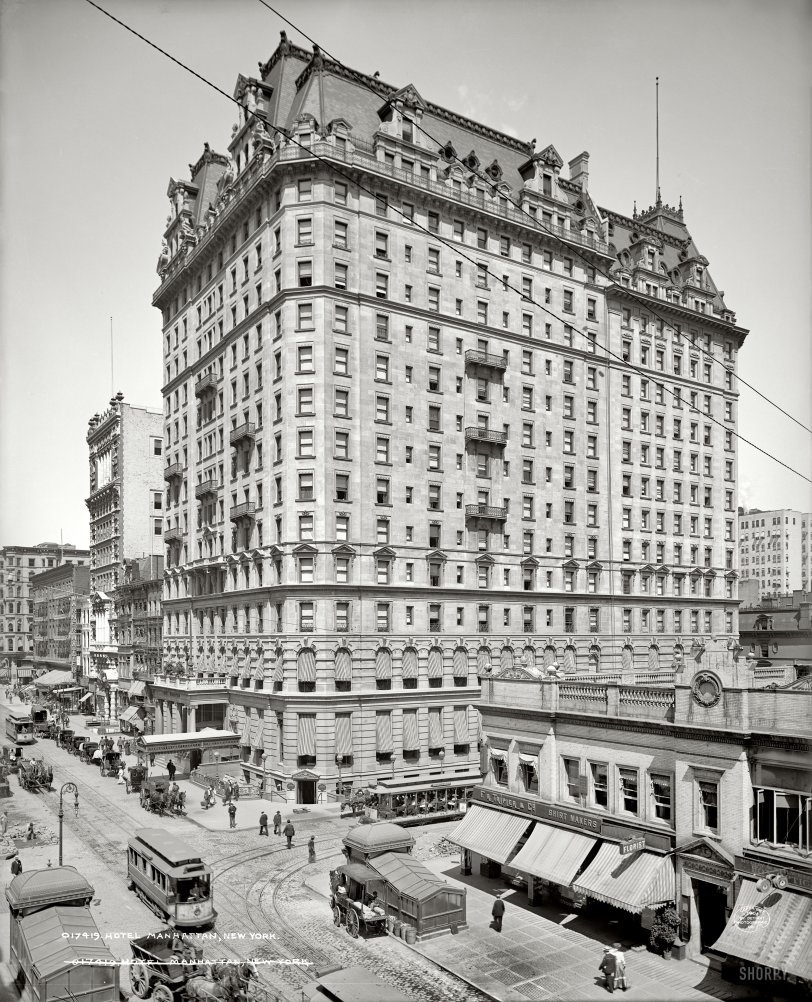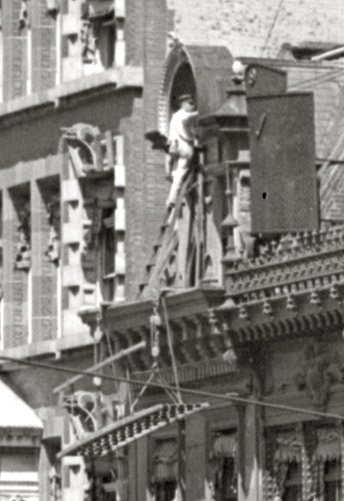


Framed or unframed, desk size to sofa size, printed by us in Arizona and Alabama since 2007. Explore now.
Shorpy is funded by you. Patreon contributors get an ad-free experience.
Learn more.

- Freeze Frame
- Texas Flyer wanted
- Just a Year Too Soon
- WWII -- Replacing men with women at the railroad crossing.
- Yes, Icing
- You kids drive me nuts!
- NOT An Easy Job
- I wonder
- Just add window boxes
- Icing Platform?
- Indiana Harbor Belt abides
- Freezing haze
- Corrections (for those who care)
- C&NW at Nelson
- Fallen Flags
- A dangerous job made worse
- Water Stop
- Passenger trains have right of way over freights?
- Coal
- Never ceases to amaze me.
- Still chuggin' (in model form)
- Great shot
- Westerly Breeze
- For the men, a trapeze
- Tickled
- Sense of loneliness ...
- 2 cents
- Charm City
- What an Outrage
- Brighton Park
Print Emporium
Hotel Manhattan: 1904

New York circa 1904. "Hotel Manhattan, 42nd Street." Another architectural view with many interesting details being peripheral to the subject at hand. 8x10 inch dry plate glass negative, Detroit Publishing Co. View full size.
I always want to visit
those beautiful little dormer rooms right up at the top and see what they are like inside!
Cable Car Fling
Several of the New York City street railway companies had a very brief fling with San Francisco style cable cars in the 1890's, transitioning from horse cars to cable cars to Washington DC style underground electric distribution in a span of 2-3 years.
To reduce the expense of the second conversion to electric power, some of the lines, including the Third Avenue Railway, found ways to retrofit the electric 3rd rail (sometimes 2 "third rails") into the existing cable trough. It appears that this is the case here, where the troughs for the 2 diverging lines swerve to run parallel with each other, as was done with cable cars, rather than joining, as done when a line was designed for electric power from the beginning.
The underground power distribution, rather than overhead wires, was per a NYC ordinance that forced all wires to be placed underground. Unlike relatively warm Foggy Bottom, it must have been a challenge to keep the New York lines operating despite snow and ice falling into the troughs, in either the cable or electric eras.
Streetcar Slots
That sharp bend in the electrical conductor slot, which was pointed out in the "Track curves" comment, is interesting. If you follow the track to the right of that point in both directions, you can see that there are what appear to be four rails for the streetcars - two running rails and two power supply slots. The power supply shoe on the cars must have been capable of side-to-side movement to stay in the slot as it veered to one side.
There's a map of the Metropolitan Street Railway system here.
As you can see from this detail, the Metropolitan cars coming down Madison had to turn onto Forty-Second to go one block east on the rails of the Forty-Second Street cross-town streetcar line, before turning back to continue down Fourth Avenue (you can see one of the large open cars just turning in from the right).
I suspect that this four-rail system must have been necessary to keep the electrical supply from the Madison/Fourth Avenue line separate from the supply for the smaller cross-town cars on Forty-Second.
Mystery of the amethyst sidewalk inserts solved!
One reason I love Shorpy is how much I learn. Seattle has many of those glass inserts still in the sidewalks, from when the underground city was up and running. I always wondered why they were purple and now I know!
Those glass sidewalks
It's always a thrill to see these. My first encounter of these was here in Saskatoon where there's a few buildings still sporting this unique method of bringing light into the basement. All the glass blocks are a lovely violet now and I even have a half block piece that was dislodged once upon a time from one of them. I love how they glow at night when the building has the lights on below, and better still, they melt snow even at extreme cold temperatures, so that the building tenants don't have to clear their sidewalks!
Banks a lot!
I remember the Tripler and Paul Stuart stores very well, as competitors to Brooks Brothers. Tripler and Stuart were known as clothiers to Ivy Leaguers, and just a tick or two above Brooks in quality and price. My tastes ran to Brooks in the 60s and 70s, but my pocketbook usually led me to Weber & Heilbroner, a block west on a NE corner of Fifth in the 40's. My first bank in New York in 1959 was in the old Hotel Manhattan structure (a Manufacturers Trust branch). I was working at that time for Union Carbide at 30 East 42nd across the street. Carbide paychecks were issued from the Hanover Trust Company in the Carbide building, but Hanover did not handle personal checking accounts. At about the same time that Union Carbide moved to a new skyscraper at 270 Park Avenue, at the head of Vanderbilt Avenue.
Manufacturers merged with Hanover to become "Manny Hanny," and opened a branch on the ground floor of the new skyscraper.
Look at the poor schmucks
who are replacing the paving stones in the lower left of the frame. Contrast with the guy on the corner who is probably looking at his gold pocket watch, for effect. This photo spans income and class spectrum entirely.
Pictures in a picture
It's always strangely gratifying whenever photography-related business or references to same pop up, and we've had two in one day: here the "KODAKS" awning next door to the hotel, and earlier the "Camera Supplies" etc. sign on a building by the Dudley Street Station. Also, thanks to Dave for remembering that I'd already waxed rhapsodic with my sidewalk skylight memories, which I was on the verge of doing again.
Death Defying Feat
My favorite picture might be these incredibly detailed cityscapes. Up near the roof of the third building up the street from from the hotel, is that a man on a ladder working on the facade? How fearless is that?

Glass Sidewalk Inserts
I love the "Coke bottle" glass inserts in the sidewalk (foreground, right side) that would provide light to the subway below.
There aren't many sidewalks that exist like that in uptown. Quite a few still exist in Soho.
[You'll note that many such inserts are amethyst colored, due to the action of the sun's UV rays over the decades -- the effect that turns old bottles purple. I think tterrace pointed that out awhile back. - Dave]
Tall Poles
I'm impressed by the very tall flagpoles we see in these old photos.
F.R. Tripler & Co
The F.R. Tripler & Company had a store at 366 Madison Avenue, at 46th Street. They were a high end clothier, custom shirt maker and haberdasher. Their competion was Brooks Brothers at 346 Madison Avenue at 44 Street (their Flagship Store) and Paul Stuart Clothing at 10 East 45th Street at Madison Avenue. All three stores occupy the corner of Madison Avenue at their Street locations. All are/were well respected quality shops. My own business was on 45th Street between 5th & 6th Avenues. I shopped at all three at one time or another. The Tripler store closed about 20 years ago and the location now houses a Jos. A. Bank clothing store, the quality is good but not in the same league as Tripler.
Let there be light
Notice the glass sidewalks in the right foreground. Thick glass set into grids to let light into cellar spaces (or the subway) under the sidewalk. More space to lease! It very rarely survives today but it was common at one time in many American cities.
A Precursor of the Plaza ...
The Hotel Manhattan was designed by Henry Hardenbergh, architect of the Dakota Apartments and the Plaza Hotel, and built in 1896-1897. It was demolished in 1961. It stood at the northwest corner of 42nd Street and Madison Avenue, just west of Grand Central. To me it resembles Washington's Willard Hotel, which Hardenbergh designed in 1901.
Check out the cool entrance kiosks for the brand new (opened 1904) IRT Subway!
Forty-Second Street
According to Emporis the Hotel Manhattan was at East 42nd and Madison. It was converted into an office building in 1922 and unfortunately demolished in 1963.
Track curves
In the immediate foreground, one of the rails of the streetcar tracks at the intersection makes a sharp "s" curve. No other visible rail matches that curve, and I doubt the rail obscured by the passing streetcar follows that curve because it would require an axle far wider than anything I've ever seen. Furthermore, I can't think of anything longer than a handtruck that could navigate that curve. Does anyone have any idea what purpose that curve serves?
[That's not a rail -- it's the slot between the tracks giving access to the electrical supply under the street. - Dave]
A Gold Mine of Peripheral Details
Dave, you have a gift for understatement. Many interesting details, indeed. Another fascinating pic 'o the past.

























On Shorpy:
Today’s Top 5